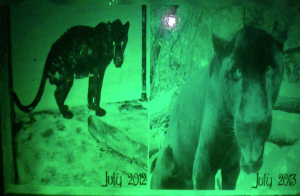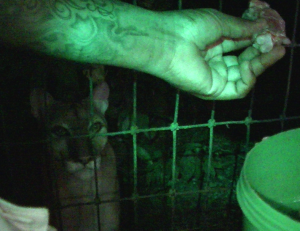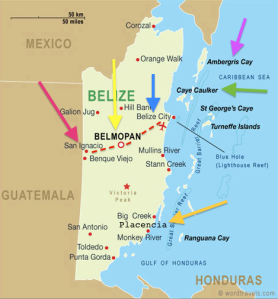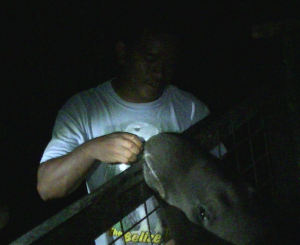It’s 5:30 am and I can’t sleep. I think I got three or four hours in, honestly.
Yesterday started off great. This wildlife course is kind of a work-in-progress, as is my understanding. Like I said, they just got a new teacher and he is not a vet. This was kind of an unexpected change and I guess some of the students were upset with the new non-medical curriculum. The main teacher, Dr. Omar, I have come to find out is quite a busy guy. I have been the main ISIS staff member around to answer student questions, make sure the students are on schedule, and [most importantly] drive them to where they need to go.
I was given two things as an ISIS employee: the keys to the van and a Belize cell phone. The van is one of those huge 14-person vans. I was surprised to find that it is really nice, since I know the van that Paige is driving in San Ignacio has been breaking down and failing to start on the reg. In fact, the ignition has a tendency of falling out onto the floor… with the key in it… and the van still continues running. I’m not quite sure how that works but I suppose I will be finding out in two weeks when I switch to TA for that class.
Our van even has air conditioning. I kind of want to live in it. Is that weird?

My biggest concern, now, are the roads of Belize. I believe there are only two paved highways in the entire country. To say the roads are paved is a generous statement. It’s more like compacted gravel. The one I am familiar with is the western highway. It essentially dissects the country in half and exists as one long, straight road that runs from east to west between Belize City and San Ignacio. San Ignacio is on the farthest west side of the country—less than 10 miles from the Guatemalan border.
I think that the speed limit is 55 mph, but there aren’t any road signs. There aren’t even any stop signs. There definitely aren’t any stop lights. Actually I heard there are a couple stop lights somewhere in the country of Belize, but they really only exist in Mennonite communities. Yes, you read that correctly. The Mennonite communities are the most technologically advanced groups of people in Belize. Pretty crazy, eh? The villages that are made up of mostly Mennonites actually resemble small, boring suburban towns in Ohio or Indiana. You know those boring towns on the side of the interstate that have random Harley Davison outlets and Advanced Auto Parts stores? That’s what Mennonite villages look like. It’s strange. There are also more traditional Mennonite villages that are more like Amish communities. I once was riding through the jungle as an ISIS student back in 2011—literally the thick of the jungle—when we came around a bend and suddenly saw a hoard of Mennonites in traditional garb marching toward the van. It was really early in the morning, too. I was told they were coming back from church. It looked like an army of Amish people marching through the jungle carrying bibles. It was one of the weirdest things I have ever seen. There are so many Mennonites in Belize that German is actually one of the top five languages spoken here.
Those were the old-school, traditional Mennonites. Like I said, most areas containing large numbers of Mennonites are surreally developed. If I’m ever in Spanish Lookout [a major Mennonite village] in the large animal course, I’ll be sure to take some pictures of the fancy stores and gas stations one can find there.
The non-Mennonite communities look more like what you would typically picture a small Central American village to look like—random grocery stores (typically owned by Chinese people and affectionately referred to by Belizeans as “Chinies”) with open garage doors in the front, fruit stands, and food carts.
Anyway, the Western Highway that I’m going to become most familiar with throughout these next two weeks is in the middle of nowhere—between Belmopan and Belize City. That’s where the zoo is. There’s really nothing out here. There’s TEC [down a 1.5 mile dirt two track off the Western Highway], The Belize Zoo about 100 yards from the entry to the TEC driveway, and two modest restaurants about 2 miles west of The Belize Zoo. That’s it. I have yet to find some kind of gas station of convenience store within convenient driving distance.
The drivers of Belize are certainly something to write home about. The traffic laws are essentially not enforced. Speed is controlled by potholes and seemingly random speed bumps. Speed bumps are typically found in areas near bus stations, convenience stores, or villages and are commonly referred to as “sleeping policemen.”
Police checkpoints exist peppered across the highway and are basically one guy standing on the side of the road next to a pickup truck checking licenses. As I said in a previous blog, they don’t seem to care if your car has 3x the suggested capacity. Drunk driving is also a big problem in Belize. During ISIS orientation we tell the students, “If a taxi cab smells like alcohol, find a different taxi.” So I have all of these things on my mind as I fulfill my role as the student chauffeur.
We started out the first day of class with three hours of lecture. Dr. Omar was basically setting the foundation for an understanding of the basic ecosystem and wildlife monitoring techniques in Belize. In summary, Belize has five major ecosystems: tropical broadleaf forest, pine savanna, wetlands, mangroves, and reefs. It is a hotspot for biological diversity and has over 590 species of birds, 140 reptile species, 149 mammal species, and 46 amphibian species. The national bird is the toucan and the national mammal is the tapir. I really like tapirs. They’re silly. Belize is the second smallest country in Central America after El Salvador. Dr. Omar also talked about different research techniques that he uses to monitor animal populations—his specialty being the jaguar—such as humane temporary trapping devices, camera systems, and radio-tracking collars. That’s all the “boring” lecture stuff I’ll make you read for now. He basically laid the groundwork before we get into the field work part of the class where we’ll practice doing some of these wildlife surveillance and research techniques.
After lecture, it was time for lunch. It was my first time driving my nine students in the ISIS van. We went to one of the two only restaurants nearby—Cheers—and I acted like an overly protective mommy making sure the students didn’t get ice in their drinks and avoided lettuce and tomatoes. I’m skeptical about Cheers because we ate there in 2011 before one girl in my class got amoebic dysentery. We tracked it back to Cheers because that was the only place where we could remember her consuming something that the rest of us didn’t—a smoothie that contained blended ice. I’m sure Cheers is fine, but Omar disappeared before I got a chance to ask him about their food safety nowadays. He disappears kind of a lot.
It’s weird being the TA. I remember my ISIS TA, Emma. I thought she was such a bad ass and I loved her. Granted, she was a veterinarian already. I feel old. Anyway, as TA I have to call the shots. None of the students know where the hell they are, so I’m the one making decisions about where to go for lunch and trying to plan fun stuff to do during the off time.
After lunch, we went bird watching. It was hot. Despite that, I still enjoy a nice hike. The hike went between the broadleaf forest and pine savanna. We didn’t see a lot of different bird species—maybe a dozen—because it was really the heat of the day and most species are less active at that time.
After bird watching, we had an hour before our next funtivity. I used my hour to lay on my bed in my underwear while two fans were blowing on my sweaty body. I wanted to take a cold shower, but the water turned off. The water and electricity go off at random. Developing country problems.
At 5, we had a lecture at the zoo. The lecturer was a really awesome lady named Sharon Matola. She’s the founder of the Belize Zoo and she’s a weird, wonderful, radical bad ass lady.
Sharon is a real animal advocate. She once smuggled a spider monkey across the Mexican border by swimming the Rio Grande with the animal balanced on her head. Sharon is the main character in the novel The Flight of the Scarlet Macaw—as she fought the political system to try to prevent the building of a dam that wiped out the habitat of an already dwindling species. She didn’t succeed there, unfortunately, but she did A LOT for the animals of Belize and Central America in general. She left the United States in the 1980s to work as an assistant on a nature documentary filmed here in Belize. At the end of the shoot, the director left her with a jaguar, two macaws, a boa constrictor, and about 20 other semi-domesticated wild animals. Semi-domesticated animals don’t do well in the wild. They see people as friends and caretakers… this causes them to get shot and hit by cars. That’s when Sharon started The Belize Zoo in her backyard. The Belize Zoo has developed into a home for problem animals—wild cats, in particular. In tropical areas like this, wild cats have a tendency to stumble upon livestock and think they hit the jackpot. When they learn this behavior, they’re essentially on borrowed time. Farmers trap them, poison them, and shoot them. If a jaguar, for example, learns about the easy meat they can get from farmland there is nowhere you can transplant them that will prevent them from seeking out another farm, more easy meat, and another farmer that will inevitably get fed up and kill them.Instead of letting problem animals assume this fate, Sharon works with local biologists to capture these predators and turns them into ambassadors at the zoo where they can be used for breeding and education of local Belizeans. Education of local Belizeans about wildlife conservation is sorely needed. With this lack of education comes ignorance that eventually leads to the killing of animals for no reason. Owls, for example, are seen as manifestations of the devil and are commonly shot and killed. Harpy eagles are shot and killed because people think that they will steal their babies. The Belize Zoo is filled with local animals that came from sad situations like that. These animals are turned into an educational resource, and ideally they are used to teach Belizeans that these wildlife species are something that should be treasured and protected. Sharon takes in these problem animals, plays guitar and sings to them, and sometimes even trains them to follow commands. The wild cats here know a lot of tricks like sit, roll over, and high five. This teaches Belizeans just how smart these animals actually are and also serves as enrichment behavior training that gives the animals something to do with their time in captivity. Junior Buddy, for example, is one such jaguar that was born here in captivity. I’ll have more to say about Junior Buddy later, I’m sure. Lucky Boy is another jaguar that came to the zoo in 2012.

Lucky Boy is near and dear to my heart because I’m fairly certain that I witnessed the beginning of his story back in mid 2011. When I did the wildlife course back in 2011, Dr. Isabelle was really involved with a neglect case. There was a resort here in Belize filled with exotic animals that the original owner left in the care of someone else. He gave this other guy money to care for the place while he was gone, but that person just took the money and abandoned the place. By the time the authorities found out about it and surveyed the premises, many of the animals were dead or in very poor condition. There were jaguars there. Lucky Boy is a black jaguar. I don’t remember a black jaguar there… so maybe this was yet another sad case. Or maybe the politics that emerged behind this case really kept it up in arms for nearly an entire year. I hope that wasn’t the case. But I also hope that there weren’t two nearly identical cases within just one year of each other. Both scenarios are bad.
I do remember another spotted jaguar at said resort, though. We got all set up to dart and move that spotted jaguar—we literally had the drugs pulled up and in the dart—when Dr. Isabelle got a call to stop immediately. The government and other wildlife agencies got involved and the situation became a hell of a lot more complicated just like that. I don’t know if Lucky Boy was also affiliated with this resort that I was at, but the story sounds extremely similar. I asked about the spotted jaguar that was found at the resort and I was informed that it died.
People are fucking assholes, sometimes.
Lucky Boy, on the other hand, is now fat and happy… and smart as fuck. He knows how to do all kinds of tricks.
With all of that being said, it was really cool to meet Sharon. At the end of her lecture about the origin of the Belize Zoo, she said she had an educational pamphlet she wanted all of us to pass around and read. She said she didn’t have enough money to print out enough copies for us all to have one, so we’d have to pass it around. She picked up a spotted bag, reached inside, and pulled out a juvenile crocodile named Rose. She told us Rose’s story—that she hatched from an egg that they found on the side of the road that they were holding onto for display purposes because they assumed the babies inside were dead. Well, Rose unexpectedly hatched out of them and she, too, became an education animal to teach people to stop the killing crocodiles. I’m really passionate about wildlife conservation and saving the environment, so I almost cried during Sharon’s talk. It was really cool to meet a woman who is so involved with this stuff and has gone to such extremes to be a voice for animals.
Sharon’s talk got over at 6. I had to hurry up and get the students back to TEC for dinner and then back to the zoo again at 7 for a night tour. Omar was in and out of meetings all afternoon and evening so it was up to me to keep everyone on schedule. I was scrambling a little bit. The students were all exhausted at this point and a couple of them are already battling digestive upset issues. They’re all adults between the ages of 19 – 21, so I shouldn’t feel so responsible for them—but I do. After dinner, I told everyone to dress in long pants and long sleeves and to coat themselves in a thick layer of DEET because we were going on a 2-hour night tour of the zoo.
I went on a night tour of the zoo back in 2011. It’s a really cool experience. A lot of the animals here are nocturnal—the cats, especially. There are also the owls, kinkajou, and the tapirs. All of these animals become exceptionally active at night. This night tour was even better than the last one I went on because the cats were crazy active. All the jaguars were out as were the ocelot, the margay, and the puma. — puma photo
The tapirs, coatimundis, and kinkajou also came out to see us. We could also hear all the howler monkeys calling which is a really eerie sound. They sound like dinosaurs. In fact, the sound of howler monkey calls were used as dinosaur sounds in Jurassic Park. That’s a fucking fact, y’all.

SO that was pretty cool. I got back from the night tour, happy as a clam, then things went to shit. I checked my e-mail and it turns out my former cat—Jean Claude—had to get put to sleep. The story of my cats is a complicated one, but to summarize as best I can [which isn’t a very strong skill of mine]:
My life has changed a lot in the past 2 years. Back in 2012, I had a boyfriend of 8 years, two dogs, two cats, and a pretty set-in-stone routine. One day, all of that changed and I found myself alone with four animals. Before I went to India, I found a wonderful foster family to watch my cats Nigel & Jean Claude. They both have feline leukemia. After India, the family fell in love with my two cats. The family had three young children and their mother asked me if she could surprise her daughter on her 13th birthday by telling her she could keep the cats as their own. It was a really hard decision for me, but as a vet student I’m never home. I also travel a lot. The mother of this family sent me photos every week of Nigel & Jean Claude playing dress up and being cuddled by children. They got way more attention there. I made the decision to let the family adopt my kitties. I got a video of the birthday surprise when the little girl found out she could keep them. I bawled my eyes out. The past week, Jean Claude went downhill and I heard last night that he was found in his litterbox unable to get up and was rattling when he breathed. They took him to the vet and he had to get put to sleep. I feel bad for the kids. I feel bad for Nigel. The family knew what they were getting themselves into adopting cats with a terminal disease, but they took on the challenge and gave the cats a loving home anyway.
People are wonderful, sometimes…
Jean Claude lived a good life… a longer life than I ever expected he would live. I found him and Nigel under the sea lion exhibit as a zookeeper in New Orleans—less than 3 weeks old, covered in mucus, and feline leukemia positive. Him and his brother were going to be euthanized if I didn’t take them. Nigel also had a stick lodged in his eye. I took them home, weaned them, and got them healthy. 80% of cats with feline leukemia die before age 3. Jean Claude just turned four. He also survived an emergency surgery that involved the removal of two different drawstrings from his small intestine. He almost died, then. He loved eating strings… that little shithead. Rest in peace, my baby Jeany.
I read the news and started crying in the dining hall in front of my students, then ran into the jungle and wandered around for a while in the dark to try to recollect myself. Crisis girl here, reporting for duty. Then I realized my ISIS phone is nowhere to be found. I don’t know where it is. I hope it didn’t fall out of my goddamn camera bag on the night tour. I’m going to have to track that down today. So last night I laid in bed, worried about my phone, cried about Jean Claude, ate chocolate, and took Benadryl in an attempt to drug myself into sleep. It didn’t work. I probably slept for two hours last night, before I decided to just get up at around 4:30 and try to organize myself for today.
Today should be cool, though. We’re going to spend it all at the zoo hanging out with keepers. If we do the jaguar darting and wellness check-up, today will also be the day for that. Keep your fingers crossed, everyone. I could use a little pick-me-up after last night’s sudden surge of calamity after a good, successful day. That’s how Chelsea’s world works. good, Good, GOOD, GREAT… Fuck!
What is my life.


![Sharon and Brooke [ISIS student from New Mexico]](https://copacabanacapybara.files.wordpress.com/2014/07/screen-shot-2014-07-08-at-5-17-09-am.png?w=300&h=196)
